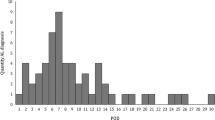Abstract
Purpose
Esophageal anastomotic leakage is still a major cause of morbidity and mortality after esophagectomy. We conducted this study to elucidate how anastomotic leakage affects the systemic inflammatory response syndrome (SIRS) criteria.
Methods
The subjects of this retrospective study were 61 patients who underwent esophagectomy. We evaluated their preoperative status, the surgical procedures, and postoperative systemic response, including white blood cell count, heart rate, respiratory rate, body temperature, and laboratory data up to postoperative day (POD) 4.
Results
Anastomotic leakage developed in nine patients (14.8%) and was found on POD 7 on average. These patients had a significantly longer hospital stay than those without leakage. Although no difference was observed in postoperative changes of any of the SIRS criteria, the postoperative incidence of SIRS was significantly higher in the patients with anastomotic leakage on POD 4. The number of positive criteria for SIRS was also significantly higher in patients with anastomotic leakage than in those without leakage on PODs 3 and 4.
Conclusions
The SIRS scoring system is valuable for evaluating the severity of systemic inflammatory response caused by anastomosis leakage, and may serve as an indicator for prompt management.



Similar content being viewed by others
References
Orringer MB, Marshall B, Iannettoni MD. Transhiatal esophagectomy: clinical experience and refinements. Ann Surg. 1999;230:392–400.
Muller JM, Erasmi H, Stelzner M, Zieren U, Pichlmaier H. Surgical therapy of oesophageal carcinoma. Br J Surg. 1990;77:845–57.
Saeki H, Masuda T, Okada S, Saeki H, Masuda T, Okada S, et al. Impact of perioperative peripheral blood values on postoperative complications after esophageal surgery. Surg Today. 2010;40:626–31.
Urschel JD. Esophagogastrostomy anastomotic leaks complicating esophagectomy: a review. Am J Surg. 1995;169:634–40.
Valverde A, Hay JM, Fingerhut A, Elhadad A. Manual versus mechanical esophagogastric anastomosis after resection for carcinoma: a controlled trial. Fr Assoc Surg Res Surg. 1996;120:476–83.
Law S, Fok M, Chu KM, Wong J. Comparison of hand-sewn and stapled esophagogastric anastomosis after esophageal resection for cancer: a prospective randomized controlled trial. Ann Surg. 1997;226:169–73.
Junemann-Ramirez M, Awan MY, Khan ZM, Rahamim JS. Anastomotic leakage post-esophagogastrectomy for esophageal carcinoma: retrospective analysis of predictive factors, management and influence on longterm survival in a high volume centre. Eur J Cardiothorac Surg. 2005;27:3–7.
Martin LW, Swisher SG, Hofstetter W, Correa AM, Mehran RJ, Rice DC, et al. Intrathoracic leaks following esophagectomy are no longer associated with increased mortality. Ann Surg. 2005;242:392–9.
Sauvanet A, Baltar J, Le Mee J, Belghiti J. Diagnosis and conservative management of intrathoracic leakage after oesophagectomy. Br J Surg. 1998;85:1446–9.
Pierie JP, de Graaf PW, van Vroonhoven TJ, Obertop H. Healing of the cervical esophagogastrostomy. J Am Coll Surg. 1999;188:448–54.
Whooley BP, Law S, Alexandrou A, Murthy SC, Wong J. Critical appraisal of the significance of intrathoracic anastomotic leakage after esophagectomy for cancer. Am J Surg. 2001;181:198–203.
Lorentz T, Fok M, Wong J. Anastomotic leakage after resection and bypass for esophageal cancer: lessons learned from the past. World J Surg. 1989;13:472–7.
Strauss C, Mal F, Perniceni T, Bouzar N, Lenoir S, Gayet B, et al. Computed tomography versus water-soluble contrast swallow in the detection of intrathoracic anastomotic leak complicating esophagogastrectomy (Ivor Lewis): a prospective study in 97 patients. Ann Surg. 2010;251:647–51.
Briel JW, Tamhankar AP, Hagen JA, DeMeester SR, Johansson J, Choustoulakis E, et al. Prevalence and risk factors for ischemia, leak, and stricture of esophageal anastomosis: gastric pull-up versus colon interposition. J Am Coll Surg. 2004;198:536–41.
Mitchell JD. Anastomotic leak after esophagectomy. Thorac Surg Clin. 2006;16:1–9.
Wong J, Cheung H, Lui R, Fan YW, Smith A, Siu KF. Esophagogastric anastomosis performed with a stapler: the occurrence of leakage and stricture. Surgery. 1987;101:408–15.
American College of Chest Physicians/Society of Critical Care Medicine Consensus Conference. Definitions for sepsis and organ failure and guidelines for the use of innovative therapies in sepsis. Crit Care Med. 1992;20:864–74.
Peel AL, Taylor EW. Proposed definitions for the audit of postoperative infection: a discussion paper. Surgical Infection Study Group. Ann R Coll Surg Engl. 1991;73:385–8.
Tsujimoto H, Ono S, Chochi K, Sugasawa H, Ichikura T, Mochizuki H. Preoperative chemoradiotherapy for esophageal cancer enhances the postoperative systemic inflammatory response. Jpn J Clin Oncol. 2006;36:632–7.
Sobin LH, Fleming ID. TNM classification of malignant tumors. 5th ed. Union Internationale Contre le Cancer/American Joint Committee on Cancer. Cancer. 1997;80:1803–4.
Tabatabai A, Hashemi M, Mohajeri G, Ahmadinejad M, Khan IA, Haghdani S. Incidence and risk factors predisposing anastomotic leak after transhiatal esophagectomy. Ann Thorac Med. 2009;4:197–200.
Pines G, Buyeviz V, Machlenkin S, Klein Y, Laor A, Kashtan H, et al. The use of circular stapler for cervical esophagogastric anastomosis after esophagectomy: surgical technique and early postoperative outcome. Dis Esophagus. 2009;22:274–8.
Haga Y, Beppu T, Doi K, Nozawa F, Mugita N, Ikei S, et al. Systemic inflammatory response syndrome and organ dysfunction following gastrointestinal surgery. Crit Care Med. 1997;25:1994–2000.
Conflict of interest
None of the authors have a conflict of interest in relation to this paper.
Author information
Authors and Affiliations
Corresponding author
Rights and permissions
About this article
Cite this article
Tsujimoto, H., Ono, S., Takahata, R. et al. Systemic inflammatory response syndrome as a predictor of anastomotic leakage after esophagectomy. Surg Today 42, 141–146 (2012). https://doi.org/10.1007/s00595-011-0049-9
Received:
Accepted:
Published:
Issue Date:
DOI: https://doi.org/10.1007/s00595-011-0049-9




